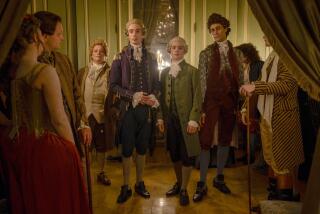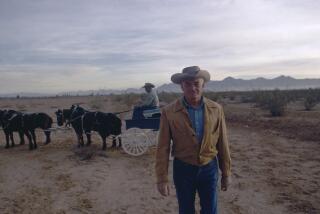In Praise of the Belt : Forget its utilitarian image. The belt is really a man’s tool of seduction, a brash advertisement to attract the woman at the end of the bar.
- Share via
So simple, at first glance. A strap. Oiled leather or alligator skin, braided or beaded. Some top stitching and a buckle. A few punch holes. But a man’s belt is more than raw materials. Whether it comes from J. Crew or Kmart, this accessory encompasses more than just girth.
The belt represents a blurring of the distinction between function and fashion, not to mention an enduring testament to the male penchant for saber-rattling. And, located in a testosterone-rich area of the body, it cannot help but serve as a standard-bearer for sexuality.
Honest.
How ironic to find so much of human nature bound up in an item of clothing normally afforded so little notice. The average man owns only a handful of belts. And that’s counting reversibles as two.
Yet, it is exactly such minutiae that demand inspection, an analysis of what the late Supreme Court Justice and fashion plate Oliver Wendell Holmes Jr. called “the great forces that are behind every detail.”
A fashion dictum if ever there was one.
So let us begin by debunking the belt’s utilitarian image. It does not serve to hold up a man’s trousers. Today’s selection of fits and styles--not to mention refinements in Sansabelt technology--accommodate a wide variety of figures.
“The belt is still a necessity,” argues a salesman for a Los Angeles belt manufacturer. “You have to put something through your belt loops.”
Of course. Circular logic. But which came first?
The belt originated in the military, the Encyclopedia of Fashion says. It gave soldiers somewhere to hang their weapons. Cummerbunds--a species of the genus--began as humble Persian loincloths and were eventually annexed by British forces occupying India. They were subsequently aggrandized as decorative sashes for officers’ dress uniforms.
In peacetime, however, this accouterment has served in an altogether different sort of battle. It’s all about sex.
The urge to procreate, to propagate the species, to get a phone number from the blonde at the end of the bar.
This primal force has turned the waistline into a Bermuda Triangle of the male anatomy, the one place on a man’s body where senseless and inexplicable things are most often sighted. Once we come to grips with this inevitability, a lot of questions get answered, a lot of mysteries are solved.
Like pretentious ostrich-skin belts or black-leather straps with the words “God Bless America” tooled in two-inch, red, white and blue letters across the back. Or cowboy buckles--silver ones the size of hubcaps.
When it comes to men and displays of sexuality, it seems, the results can prove conspicuously clumsy.
The belt, writes fashion historian Lawrence Langer, has often evolved into variations of exaggerated size. Such mass has “the obvious effect of drawing attention to what it was supposed to hide, or conversely pretending to hide what it intended to reveal.”
In other words, while women have traditionally seduced through a subtle blend of modesty and exhibition, men have resorted to brash advertisement.
*
Consider the codpiece. Men wore this belted bag or flap over the front of their tight breeches during the 15th and 16th centuries. Some resorted to padding their codpieces and decorating them with jewels.
Shakespeare, for one, saw the folly of such fashion, equating this accessory with man’s lesser inclinations. In King Lear, a character opines, “Here’s grace and a codpiece; that’s a wise man and a fool.”
Pop mythology offers another example. Batman might have amounted to less than a super-hero--just some guy in tights and a cape, perhaps--if it weren’t for his impressive utility belt. Its secret compartments afford room for a variety of necessities.
“The bat rope, gas pellets, a miniature fingerprint kit,” says Bob Greenberger of D.C. Comics. “Everything but a condom.”
Yet such excess pales in comparison to the true behemoth of the belt world--the cowboy buckle. Originally, cowboys didn’t wear belts, says James Nottage, chief curator of the Gene Autry Western Heritage Museum in Griffith Park. When these silvery adornments came into favor during the early 1900s, it was strictly prairie fashion.
“Throughout the 20th Century, there have been relatively few avenues for male jewelry,” Nottage says. “These belt buckles are an avenue for that sort of expression. They show off your prowess. They show off your economic status if they are fancy.”
Indeed, a garden variety cowboy buckle runs about $100. A stone-inlaid, sterling silver version can cost $5,000.
That is a substantial sum to spend on something with little or no practical use. In other words, it’s a lot like dating.
And Nottage shrinks at the “monstrous, gross” adaptations favored by the current urban line-dancing set.
Perhaps the one anomaly to this belt phenomenon, the single instance in which males have conceived a waistline contraption that detracts rather than attracts, is Sansabelt slacks.
Ah, the double-knit revolution of the late 1950s. Aimed at the “big and tall” golfing scene, Sansabelt offered a patented waistband--not a single belt loop on it--and “no roll” protection. Sounds like something you might bolt to a Jeep.
These slacks came in a nightmare of colors that could be appreciated only in country club lounges. Or by Ed McMahon. Yet even Sansabelt, in its peculiar self-conscious manner, served to give men slimmer and more attractive figures.
Remember, it’s all about sex.







